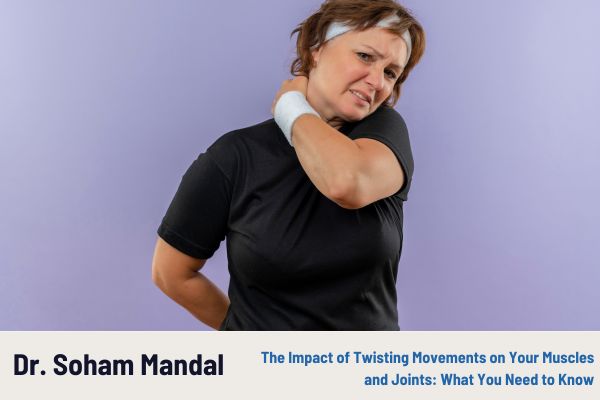The Impact of Twisting Movements on Your Muscles and Joints: What You Need to Know with Dr. Soham Mandal
Twisting movements are a natural part of our daily lives, whether it’s reaching to the side, turning while walking, or participating in sports activities. However, these movements can sometimes lead to muscle strain, joint injuries, and spinal issues if not done properly. Understanding how twisting impacts your body and taking preventive measures is key to staying pain-free and maintaining optimal mobility.
Dr. Soham Mandal, an expert in orthopedics and joint care, helps break down the mechanics of twisting movements and provides valuable insights on how to protect your muscles and joints from injury.
The Mechanics of Twisting Movements
When we twist, our body rotates around its spinal axis, engaging muscles, tendons, and ligaments in the process. Twisting can place significant pressure on your spine, shoulders, hips, and knees, making them susceptible to strain, especially when the movement is abrupt or excessive.
Commonly affected areas of the body during twisting movements include:
- Spine: The vertebrae and discs in the spine are especially vulnerable to damage during improper twisting, which can lead to disc herniation or bulging.
- Lower back: The muscles of the lower back, particularly the erector spinae, bear much of the strain, making them prone to injury if not properly conditioned.
- Shoulders and neck: Rotator cuff injuries and neck strains are common during rapid or forceful twisting movements, especially when lifting objects overhead.
- Knees and ankles: Twisting can also affect the ligaments in the knee and ankle, leading to injuries like ACL tears or sprains.
Common Injuries from Twisting Movements
Muscle strain and ligament sprains are among the most frequent injuries caused by twisting movements. Some common conditions resulting from twisting include:
- Muscle strain: A tear or overstretch of the muscle fibers, often in the back, shoulders, or legs.
- Spinal injuries: Twisting too far or too quickly can lead to issues like herniated discs, which cause severe back pain.
- Rotator cuff injuries: The shoulder joint is highly susceptible to injury during twisting movements, especially when reaching or lifting.
- Knee and ankle sprains: Twisting your knees or ankles can stretch or tear ligaments, leading to instability and pain.
Prevention Tips
To reduce the risk of injury from twisting movements, here are some expert prevention tips from Dr. Soham Mandal:
- Warm-up before activity: Ensure that your muscles are prepared for any movements by doing proper warm-up exercises, especially focusing on flexibility.
- Maintain proper posture: Avoid twisting your spine excessively and always maintain proper posture when turning or bending to avoid strain.
- Strengthen muscles: Build strength in your core muscles, back, and shoulders to provide stability and support during twisting motions.
- Move slowly and deliberately: Avoid jerking or sudden movements. Focus on controlled, smooth twists to reduce unnecessary strain.
- Use ergonomic techniques: When lifting objects or turning, use the correct posture by bending at the knees and engaging your core, rather than twisting at the waist.
Treatment for Twisting Injuries
If you do experience a twisting injury, it is essential to seek medical attention early. Treatment for twisting-related injuries may include:
- Rest and ice: Ice packs can help reduce swelling, and resting the affected area prevents further strain.
- Physical therapy: Rehabilitation with a physical therapist can strengthen the affected muscles and improve flexibility.
- Medication: Pain relievers and anti-inflammatory medications can ease pain and reduce swelling.
- Surgical intervention: In severe cases, such as disc herniation or ligament tears, surgery may be necessary to repair the damage.
Conclusion
Twisting movements are a part of everyday life, but they can sometimes lead to injury if not executed properly. By understanding how twisting affects your muscles and joints, you can take proactive steps to prevent injury. Proper warm-ups, strengthening exercises, and maintaining good posture are essential to keeping your body healthy and free from strain. If you do suffer from a twisting-related injury, don’t hesitate to reach out to a specialist like Dr. Soham Mandal for a tailored treatment plan.

